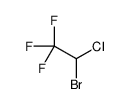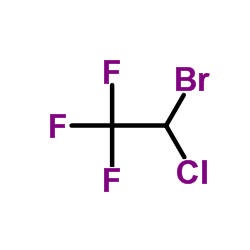754-19-8
| 中文名 | 三氟氯溴乙烷-d |
|---|---|
| 英文名 | 1-bromo-1-chloro-1-deuterio-2,2,2-trifluoroethane |
| 英文别名 |
1-bromo-1-chloro-1-deuterio-2,2,2-trifluoro-ethane
2-bromo-2-chloro-1,1,1-trifluoroethane-d 2-Deuterio-1,1,1-trifluor-2-chlor-2-bromethan Halothane-d |
| 分子式 | C2HBrClF3 |
|---|---|
| 分子量 | 197.38200 |
| 精确质量 | 195.89000 |
| LogP | 2.50850 |
|
Section1. IDENTIFICATION OF THE SUBSTANCE/MIXTURE Product identifiers Product name: 2-Bromo-2-chloro-1,1,1-trifluoroethane-d Relevant identified uses of the substance or mixture and uses advised against Identified uses: Laboratory chemicals, Manufacture of substances Section2. HAZARDS IDENTIFICATION Classification of the substance or mixture Classification according to Regulation (EC) No 1272/2008 [EU-GHS/CLP] Skin irritation (Category 2) Serious eye damage (Category 1) Reproductive toxicity (Category 1B) Specific target organ toxicity - single exposure (Category 3) Classification according to EU Directives 67/548/EEC or 1999/45/EC May cause harm to the unborn child. Risk of serious damage to eyes. Irritating to respiratory system and skin. Label elements Labelling according Regulation (EC) No 1272/2008 [CLP] Pictogram Signal wordDanger Hazard statement(s) H315Causes skin irritation. H318Causes serious eye damage. H335May cause respiratory irritation. H360May damage fertility or the unborn child. Precautionary statement(s) P201Obtain special instructions before use. P261Avoid breathing dust/ fume/ gas/ mist/ vapours/ spray. P280Wear protective gloves/ eye protection/ face protection. P305 + P351 + P338IF IN EYES: Rinse cautiously with water for several minutes. Remove contact lenses, if present and easy to do. Continue rinsing. P308 + P313IF exposed or concerned: Get medical advice/ attention. Supplemental Hazardnone Statements According to European Directive 67/548/EEC as amended. Hazard symbol(s) R-phrase(s) R61May cause harm to the unborn child. R41Risk of serious damage to eyes. R37/38Irritating to respiratory system and skin. S-phrase(s) S53Avoid exposure - obtain special instructions before use. S23Do not breathe vapour. S26In case of contact with eyes, rinse immediately with plenty of water and seek medical advice. S36/37Wear suitable protective clothing and gloves. S45In case of accident or if you feel unwell, seek medical advice immediately (show the label where possible). Restricted to professional users. Other hazards - none Section3. COMPOSITION/INFORMATION ON INGREDIENTS Substances Synonyms: Halothane-d Formula: C2DBrClF3 Molecular Weight: 198,39 g/mol ComponentConcentration 2-Bromo-2-chloro-1,1,1-trifluoroethane-d - Section4. FIRST AID MEASURES Description of first aid measures General advice Consult a physician. Show this safety data sheet to the doctor in attendance. If inhaled If breathed in, move person into fresh air. If not breathing, give artificial respiration. Consult a physician. In case of skin contact Wash off with soap and plenty of water. Consult a physician. In case of eye contact Rinse thoroughly with plenty of water for at least 15 minutes and consult a physician. If swallowed Never give anything by mouth to an unconscious person. Rinse mouth with water. Consult a physician. Most important symptoms and effects, both acute and delayed Lowered blood pressure, narcosis, Dizziness, Drowsiness, Confusion., Unconsciousness Indication of any immediate medical attention and special treatment needed no data available Section5. FIREFIGHTING MEASURES Extinguishing media Suitable extinguishing media Use water spray, alcohol-resistant foam, dry chemical or carbon dioxide. Special hazards arising from the substance or mixture Carbon oxides, Hydrogen chloride gas, Hydrogen bromide gas, Hydrogen fluoride Advice for firefighters Wear self contained breathing apparatus for fire fighting if necessary. Further information no data available Section6. ACCIDENTAL RELEASE MEASURES Personal precautions, protective equipment and emergency procedures Use personal protective equipment. Avoid breathing vapors, mist or gas. Ensure adequate ventilation. Evacuate personnel to safe areas. Environmental precautions Prevent further leakage or spillage if safe to do so. Do not let product enter drains. Methods and materials for containment and cleaning up Soak up with inert absorbent material and dispose of as hazardous waste. Keep in suitable, closed containers for disposal. Reference to other sections For disposal see section 13. Section7. HANDLING AND STORAGE Precautions for safe handling Avoid exposure - obtain special instructions before use.Avoid contact with skin and eyes. Avoid inhalation of vapour or mist. Normal measures for preventive fire protection. Conditions for safe storage, including any incompatibilities Store in cool place. Keep container tightly closed in a dry and well-ventilated place. Containers which are opened must be carefully resealed and kept upright to prevent leakage. Light sensitive. hygroscopic Handle and store under inert gas. Specific end uses no data available Section8. EXPOSURE CONTROLS/PERSONAL PROTECTION Control parameters Components with workplace control parameters Exposure controls Appropriate engineering controls Handle in accordance with good industrial hygiene and safety practice. Wash hands before breaks and at the end of workday. Personal protective equipment Eye/face protection Tightly fitting safety goggles. Faceshield (8-inch minimum). Use equipment for eye protection tested and approved under appropriate government standards such as NIOSH (US) or EN 166(EU). Skin protection Handle with gloves. Gloves must be inspected prior to use. Use proper glove removal technique (without touching glove's outer surface) to avoid skin contact with this product. Dispose of contaminated gloves after use in accordance with applicable laws and good laboratory practices. Wash and dry hands. The selected protective gloves have to satisfy the specifications of EU Directive 89/686/EEC and the standard EN 374 derived from it. Body Protection Complete suit protecting against chemicals, The type of protective equipment must be selected according to the concentration and amount of the dangerous substance at the specific workplace. Respiratory protection Where risk assessment shows air-purifying respirators are appropriate use a full-face respirator with multi-purpose combination (US) or type AXBEK (EN 14387) respirator cartridges as a backup to engineering controls. If the respirator is the sole means of protection, use a full-face supplied air respirator. Use respirators and components tested and approved under appropriate government standards such as NIOSH (US) or CEN (EU). Section9. PHYSICAL AND CHEMICAL PROPERTIES Information on basic physical and chemical properties a) AppearanceForm: clear, liquid Colour: colourless b) Odourno data available c) Odour Thresholdno data available d) pHno data available e) Melting point/freezingno data available point f) Initial boiling point and 50,2 °C - lit. boiling range g) Flash pointno data available h) Evaporation rateno data available i) Flammability (solid, gas) no data available j) Upper/lowerno data available flammability or explosive limits k) Vapour pressureno data available l) Vapour densityno data available m) Relative density1,881 g/cm3 at 25 °C n) Water solubilityno data available o) Partition coefficient: n- no data available octanol/water p) Autoignitionno data available temperature q) Decompositionno data available temperature r) Viscosityno data available s) Explosive propertiesno data available t) Oxidizing propertiesno data available Other safety information no data available Section10. STABILITY AND REACTIVITY Reactivity no data available Chemical stability no data available Possibility of hazardous reactions no data available Conditions to avoid Avoid moisture. Incompatible materials Strong oxidizing agentsStrong oxidizing agents, Rubber, Plastics, Chemically active metals Hazardous decomposition products Other decomposition products - no data available Section11. TOXICOLOGICAL INFORMATION Information on toxicological effects Acute toxicity LD50 Oral - rat - 6.700 mg/kg Inhalation: no data available Skin corrosion/irritation no data available Serious eye damage/eye irritation no data available Respiratory or skin sensitization no data available Germ cell mutagenicity no data available Carcinogenicity IARC:No component of this product present at levels greater than or equal to 0.1% is identified as probable, possible or confirmed human carcinogen by IARC. Reproductive toxicity Presumed human reproductive toxicant Specific target organ toxicity - single exposure Inhalation - May cause respiratory irritation. Specific target organ toxicity - repeated exposure no data available Aspiration hazard no data available Potential health effects InhalationMay be harmful if inhaled. Causes respiratory tract irritation. IngestionMay be harmful if swallowed. SkinMay be harmful if absorbed through skin. Causes skin irritation. Eyes Causes eye burns. Signs and Symptoms of Exposure Lowered blood pressure, narcosis, Dizziness, Drowsiness, Confusion., Unconsciousness Additional Information RTECS: Not available Section12. ECOLOGICAL INFORMATION Toxicity no data available Persistence and degradability no data available Bioaccumulative potential no data available Mobility in soil no data available Results of PBT and vPvB assessment no data available Other adverse effects no data available Section13. DISPOSAL CONSIDERATIONS Waste treatment methods Product Offer surplus and non-recyclable solutions to a licensed disposal company. Contact a licensed professional waste disposal service to dispose of this material. Contaminated packaging Dispose of as unused product. Section14. TRANSPORT INFORMATION UN number ADR/RID: -IMDG: -IATA: 3334 UN proper shipping name ADR/RID: Not dangerous goods IMDG: Not dangerous goods IATA:Aviation regulated liquid, n.o.s. (2-Bromo-2-chloro-1,1,1-trifluoroethane-d) Transport hazard class(es) ADR/RID: -IMDG: -IATA: 9 Packaging group ADR/RID: -IMDG: -IATA: - Environmental hazards ADR/RID: noIMDG Marine pollutant: noIATA: no Special precautions for user no data available SECTION 15 - REGULATORY INFORMATION N/A SECTION 16 - ADDITIONAL INFORMATION N/A |
| 符号 |



GHS05, GHS07, GHS08 |
|---|---|
| 信号词 | Danger |
| 危害声明 | H315-H318-H335-H360 |
| 警示性声明 | P201-P261-P280-P305 + P351 + P338-P308 + P313 |
| 个人防护装备 | Eyeshields;full-face respirator (US);Gloves;multi-purpose combination respirator cartridge (US) |
| 危险品运输编码 | UN 3334 |
|
~93% 
754-19-8 |
| 文献:Francesconi, R.; Lunelli, B.; Comelli, F. Zeitschrift fuer Physikalische Chemie (Muenchen, Germany), 1991 , vol. 174, # 1 p. 109 - 118 |
| 上游产品 1 | |
|---|---|
| 下游产品 0 | |

